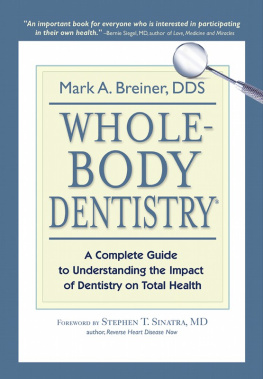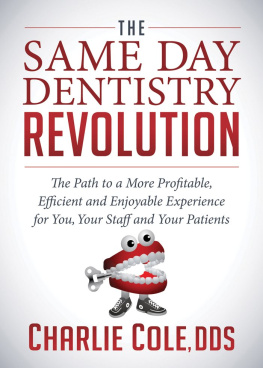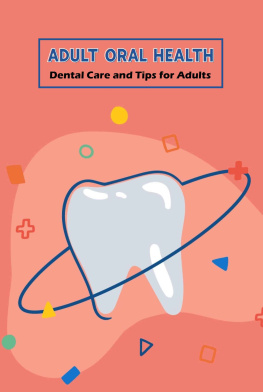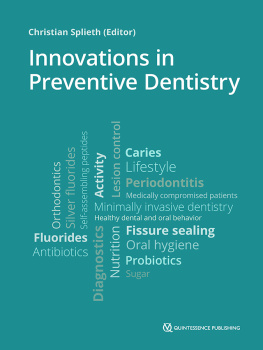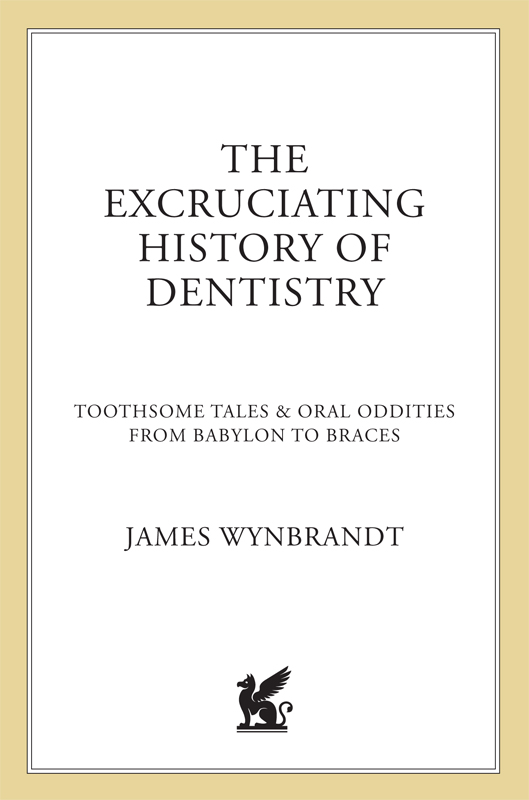Contents
Guide

The author and publisher have provided this e-book to you for your personal use only. You may not make this e-book publicly available in any way. Copyright infringement is against the law. If you believe the copy of this e-book you are reading infringes on the authors copyright, please notify the publisher at: us.macmillanusa.com/piracy.
Contents
1. Demons, Worms, and Excess Fluids
Suspected Causes and Horrific Cures of the Ancient Worlds Dental Problems
2. From Swindling Charlatans to Bleeding Barbers
The Incompetence of Tooth-Drawers Is Equalled by the Barbarity of Barber-Surgeons
3. Is There a Dentatore in the House?
Professional Dentistry Emerges in the Glow of the Enlightenment and a Gargle of Urine
4. The American Experience
Dental Care Comes to the New World, Sparking a Revolution
5. A New Era in Teethpulling
Anesthetics Usher in Painless Dentistry
6. Licensed to Drill
Dentistry in the Era of Robber Barons and Reformers
7. False Promise
Dentures and Dental Prosthetics through History
8. X-Ray Martyrs
Toxic, Addictive, Deadly, and Disgusting Substances Turned on the Teeth
9. Disposable Income and Permanent Teeth
A Century of Progress Builds a Dental Bridge to a New Era of Oral Care
10. The Million-Dollar Smile
Dentistry, Hollywood, and Oral Image-Making
The author wishes to thank the staffs and facilities of the New York University Dental Library; the library and Malloch Rare Book Room of the New York Academy of Medicine; the New York Public Library and its Rare Books and Manuscripts Division; the American Dental Association Library and the Dr. Samuel D. Harris National Museum of Dentistry; and to the many individuals who so freely shared their time and knowledge. Special thanks to Dr. John Hyson and Aletha Kowitz for their encouragement and assistance and to the members of the American Academy of the History of Dentistry for their inspiring dedication to the rediscovery and preservation of the professions heritage. A deep debt of gratitude also to Charlie Spicer and Madeleine Morel, without whom this work would not have been possible.
The distinctive high-speed glissando ascending in the background. The peculiar odor of flavored antiseptic mingling with vaporized enamel. The clip from The Marathon Man that loops through the head and the tightening sphincter. Welcome to the dentists office, an experience of sight, sound, smell, and sensation evoking a Proustian hell of remembrance.
As patients settle back into the contoured reclining chaira direct descendant of the pioneering modern model now housed in the Smithsonian Institutionthose who find the dental visit traumatic should consider how fortunate they actually are. Had their appointments been scheduled a little earliersay, the first part of the twentieth centurythey might have been blasted with dangerous levels of radiation or had a handful of perfectly good teeth pulled to promote general health. If, due to scheduling conflict, the visit had been moved up a couple of centuries, the patient might have been bled, blistered, or burned in the name of pain relief. Or the dentist might just as likely have administered a deadly dose of arsenic as recommended a simple urine rinse as a palliative. Or perhaps the patient might have found himself onstage before a lusty crowd, at the mercy of a tooth-drawer, the perfidious practitioner who is among the progenitors of this belatedly ennobled profession.
The legion of dental phobics and others whose whine rises in tandem with that of the drill would do well to stifle their terror and instead offer thanks to Apollonia, patron saint of toothaches sufferers. For today they face only fleeting discomfort rather than the disfiguring distress or slow agonizing death oft meted out by dental health-care providers of the past. The transition from yesterdays ignorance, misapprehension, and superstition to the enlightened and nerve-deadened protocols of today has been a long, slow, and very painful process. Though study of this bloody and violent evolution may set ones teeth on edge, I can make a pledge regarding its reading that is typically dismissed out of hand when offered in a professional setting: This wont hurt a bit.
The origins of the ancient healing arts known today as dentistry are obscure, a tale cloaked in equal parts mystery and misery. What is known is that throughout much of recorded time, dentistry has been advanced at the hands of inept practitioners, some with the best of intentions, others with the most venal motives. For dental patients, the clinical outcomes arising from these opposing approaches typically differed little. In either case, treatment for dental problems has historically been more bloody and barbarous than beneficial. If anything can blunt the sting of this painful fact, perhaps it is the recognition that in suffering dental distress and sundry oral afflictions, man is not alone.
Defective dentition has plagued living creatures for at least a quarter billion yearseven before they had teeth. A fossil from a Devonian sea that submerged present-day Ohio some 250 million years ago records the oldest traumatic dental injury yet identified. The petrified remains of a fishlike creature twenty feet long bear the scar of an abrasion caused by its cuspidlike dental organs, as though the jaw had been unnaturally forced closed. We can only speculate what massive force could have caused such an injury, or how much it would cost to have it treated today.
Evidence of the more insidious destruction of decay goes back 100 million years. Fossils from the Permian period of the Paleozoic era show the unmistakable signs of bacterial invasion of periodontal tissue. (A term that encompasses gums and bone that support the teeth, though in the case of fossils, the gums have long since receded.)
The earliest evidence of dental cariestooth decay, in common parlancedates to the same era, found in the tooth of a herbivorous dinosaur of the Cretaceous period. Fish of this period likewise endured a destructive process similar to caries.
We can deduce that periodontosis (bacterial destruction of the periodontal tissue) was rampant on land by the Miocene epoch of the Cenozoic era. The mandible of a three-toed horse of the period shows clear signs of destructive decay. Mighty mastadons also had dental problems, and so did camels, cave bears, and most other species of the time identified in fossil remains. Underscoring the severity of potential dental problems faced by ancient animals is the case of an impacted tooth in a saber-toothed tiger found in the La Brea tar pits in Los Angeles.
As the saber-toothed tiger sank into the tar, mired in pain, history awaited a creature capable of leaving a written record of its oral dilemmas and the woeful inadequacy of their treatment.
Of Caveman and Cavities
E ARLY MAN WAS spared the misery of tooth decay; without refined sugar in his diet, caries were relatively rare. Nonetheless, toothaches and other dental maladies abounded. Most problems arose from excessive wearing of the teeth, caused by a combination of powerful jaw muscles and a coarse diet leavened with sand, dirt, and grit from grinding bowls. Extreme wear is seen in the dental remains of all prehistoric cultures. By the end of a cavepersons relatively short life, teeth were often so worn that the pulps were exposed. Bone loss indicative of severe gingivitis (gum disease) is also visible from remains.


